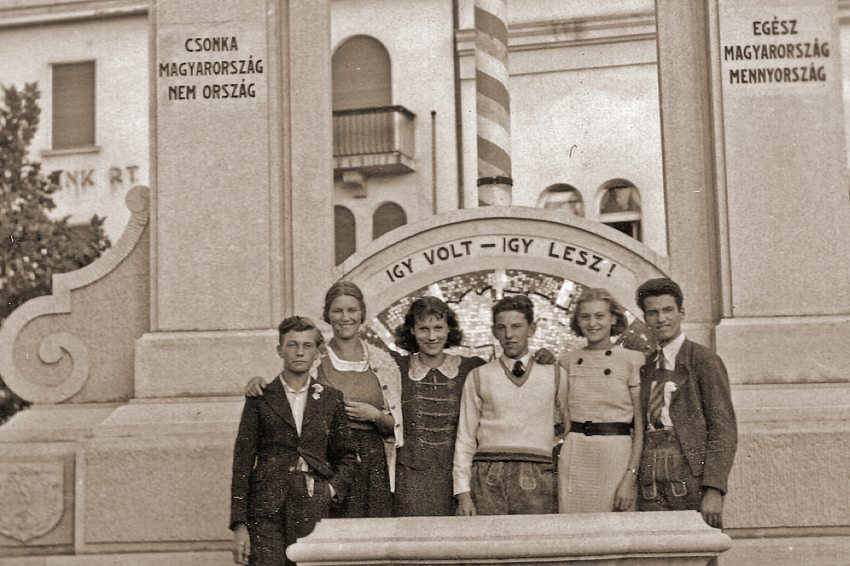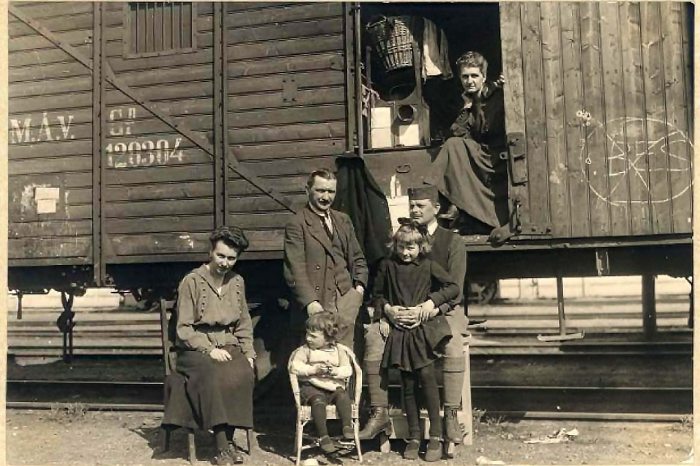If the body of the nation is sick, the individual sickens, too
Of all the losses caused by Trianon, the human loss hurts most, says Balázs Ablonczy, head of the Trianon 100 research group of the Research Centre for the Humanities of the Hungarian Academy of Sciences. If the borders had been drawn with just a little more justice, then approximately a half of the some 3.2–3.4 million detached Hungarians would have remained within Hungary.

Is there any particular personal motivation that guided you towards researching Trianon?
“As a theatre critic, my father spent a lot of time with theatres beyond the border. I had my first passport when just three months old, when we went to see theatres in Oradea (Nagyvárad), Sfântu Gheorghe (Sepsiszentgyörgy) and Satu Mare (Szatmárnémeti). It happened that nearly the entire company of the Satu Mare Northern Theatre camped in our garden – these were great intellectual meetings so I was sensitized to the subject.”
What do we call Trianon: an unhealing wound, a bottomless well of painful memories, which can never be buried?
“The saying goes that with the passage of two or three generations, historical events cool down and become cold memory. Compared to this, the memory of Trianon is still alive today, partly because in the past century around one million people crossed into Hungary from the areas cut away, in several waves. When reckoned together with their descendants, this means that perhaps two to three million people are living in Hungary today who have some sort of association with the divested areas. In itself, the very existence of Hungarians beyond the border regenerates that sense of loss. This trauma should have been processed – only, it could not be worked through in the 20th century. In the interwar period, the good Hungarian was the one who said everything, or at least the majority, should be returned, while after 1945 this was a forbidden subject.”
How can one speak about Trianon today? Many are of the belief that with the customs union and a unifying Europe, it is no longer worth talking about Trianon.
“We have to find those turns of phrase that allow us to talk about it even at international forums.
“The world is not going in the direction where those types of argument such as the Holy Crown and one thousand years have any influence, because this manner of speech is currently not valid in the world – it is possible, however, that in a few decades it will be. Today, it is permitted to speak of minority issues, autonomy and linguistic rights. Every age has its own language.”
Now that the question of autonomy has been raised, to what degree should this be dealt with in relation to the commemorative year?
“Autonomy is important and necessary, but for example the issues of Transylvanian Hungarians are not going to be resolved if, at some stage, there is regional autonomy in the land of the Szeklers. Approximately one half of Transylvanian Hungarians live in Szekler land. The other half do not live there, and they too require institutions, schools, language rights and local government. The majority of Transylvanian Hungarians live in scattered populations, that is, in settlements where they are in the minority, perhaps a minority of under 20%, for example Cluj-Napoca (Kolozsvár), Timisoara (Temesvár) and Arad. Of course, there are forms other than just regional-based autonomy, for example, cultural-based autonomy, or even combinations of the two. But it is already evident that the concept whereby we establish a little Hungary in the land of the Szeklers and from then on everything with be fine, simply does not work.”
Recently, the Trianon speech by Count Albert Apponyi was broadcast on the radio, in which, amongst other topics, he enumerated our losses, primarily from an economic aspect. But it is obvious that the economic losses are not the most painful to bear.
“The human loss hurts most. If the borders had been drawn with just a little more justice, then approximately a half of the some 3.2–3.4 million detached Hungarians could have remained within Hungary. We are talking about 20-30 kilometres. The strip in Slovakia’s upland (Felvidék) that was returned to Hungary in 1938 was, at its widest point, perhaps 60–70 kilometres, but there were parts just 20 kilometres wide. I think that the First Vienna Award established ethnically fair borders; it is another question as to the circumstances in which it came about. There is very frequent mention of the fact that 97% of our pine forests were taken, and the ore mines, but let’s not forget that even at that time we could speak of an open, globalizing economy. It is not essential for one country to have everything – copper mines, salt mines, pine forests – because these things circulate in a functioning global market, it is possible to buy them. The processing industry was here, the mines there, there was a railway and fairly advanced shipping, these things could have been resolved. It is no coincidence that at that time the biggest competitor to the Hungarian grain industry was the rising American market because cereals could easily be shipped over the ocean. But Argentinian beef also started to gain a foothold before the First World War.
“Béla Tomka’s paper on this subject caused somewhat of an outcry. He made two assertions: one was that the greatest pain was not the loss of mineral resources, the second that the Hungarian economy got back on its feet relatively quickly after Trianon. By saying this, he claimed that the economy was able to get over the losses relatively soon. New branches of industry started to appear in the early 1920s: this was the time when the Hungarian textile industry and Hungarian chemical industry began to take off. These boosted the Hungarian economy, which began to drop behind European development during state socialism due to erroneous concepts concerning industrial development and the introduction of a Soviet-style system. Rather, the bigger problem was that the Trianon ruling shattered market sectors that had formed over centuries. Where do we go to the fair? Where do we find ourselves a wife? Where should our children go to school?
“The peace treaty smashed these relatively organically established economic ecosystems and because of this, dead regions came into being on both sides of the border.
“At one time, Fiľakovo (Fülek) hardware was a classy brand. One hundred years later, this once prosperous region has become a part of Slovakia most afflicted by crisis and not only because of the Roma inhabitants and depopulation. Data from ten years earlier: the proportion of diseases of modern civilization among Hungarians in the southern Slovakia region is 40% higher than the Slovak average.”
Could this be one of the long-term knock-on effects of the peace treaty? Weren’t the health consequences noticeable in the short term, that is, almost straight away?
“One can understand from the memoirs of archaeology professor Gyula László that their crossing into Hungary was nothing other than a constant story of illness: typhus epidemic, my mother fell ill, I nearly drowned in the river...
“The body of the nation is sick, and it is as though this would make the individual sick as well. This may appear to be a fanciful interpretation, but falling ill, and not only in memoirs, is a recurring motif.
“I have read a great many housing office applications and everyone details either that the Oláhs (Vlachs or Wallachians) beat them near to death, or they give details of their illnesses. In memoirs there are very many nervous pathologies, many clinical diagnoses rather difficult to determine these days, such as neurasthenia, nervous exhaustion, nervous fatigue. We just don’t know what these diagnoses covered at that time. The mayor of Alba Iulia (Gyulafehérvár) quit the town even before the incursion of the Romanians and he died in a mental asylum in Pest a few years later. Furthermore, the mayor of Bardejov (Bártfa) went mad, as did the mayor of Levoča (Lőcse). There were people who didn’t know what to do once the world around them had collapsed. Thus the great national tragedy appears in day-to-day life, in the stories of everyday people. When we speak of the peace treaty of Trianon, we rarely speak about the fact that the drawing of a line in Paris would have consequences driving a mayor to a breakdown, that Levice (Léva), at one time a thriving market town, would begin to die, and that refugees would suddenly appear in even the smallest Hungarian settlements.”
What would have happened if… Trianon had never occurred? Where would these contrasts (buried by the peace treaty) have led?
“I don’t think that what would have been, if is not a valid question. I don’t think that we would have been able to sustain historical Hungary in unchanged form over decades. But let’s suppose that things stayed the same: it’s certain that there would have been significant masses of nationalities in the country, and the fact that this country is a multi-ethnic country should be reflected in political rights and language rights. There would have been little chance that the Romanians or Serbs living here would be totally assimilated as Hungarians. On the other hand, the contemporary Hungarian elite was very quick to embrace those Slovaks who were prepared to become Hungarian at least in part.
“The message was that if you become Hungarian, you can become anything: Hungary’s first knight banneret, indeed, the cardinal archbishop of Esztergom.
“After the First World War, Hungary was riven not only by nationality fault lines but there was a peasant-urban tension due to the rapid pace of development and tensions between the emerging Jewish middle class and Christian middle class also appeared. If there had been a coming together, or at least some kind of social cohesion, then in all likelihood it would have been possible to achieve somewhat more favourable borders, partly through armed self defence, or by arranging some kind of political consensus more quickly, and then perhaps the Hungarian peace delegation would have gone to the negotiations earlier – but even that is not certain. Trianon wouldn’t have happened this way, that is, that 3.2 million Hungarians out of 10 million – every third person, a third of the nation – being separated. Thus it is not useless to play with the idea of what would have been, if but it is only suitable for short-term projections and not to outline an alternative history. Here we would be moving into the world of novel-writing.”
Talking about the world of imagination, a whole series of Hungarian films has won international prizes but not one deals with Trianon and the fate of the ‘railway wagon residents’. What is the reason for this? After all, this period is a treasure trove rich in action, twists and turns.
“A while back I was asked to take part in a film club connected to Trianon and the discussion afterwards, and together with the organizers we sweated blood over finding a good, Trianon-related film. There aren’t any. I know of certain film outlines but it appears that there won’t be a film for the anniversary. But there should be, many of them, because the younger generation basically sources its knowledge from movies. The majority of young people acquired their understanding of 1956 from the film ‘Children of Glory’. I am all for such a film, as I am for the idea of a Trianon museum in Budapest, if it is done well. One can no longer win over the young generation with the unveiling of new statues. Other ways have to be found to get information across.”
At present, there are 15,000 names on the database of Trianon refugees made public on the website. More and more stories and family histories are constantly coming in. What can one conclude from these?
“When we published the names of refugees last June, the letters started pouring in. They started scanning grandpa’s diary written in the wagon.
“If there is any sense in historical research, then it is this: making the largely forgotten story of how many people moved to Hungary from the areas cut away after Trianon a common national history.”
What do we learn from the diaries and memoirs?
“I looked at the memoirs – and here I stress not diaries, which are written in the heat of the moment, but memoirs written a bit later – from the point of view of who explained why they came across. This is a very wide spectrum from László Ravasz and professor of archaeology Gyula László to Gyula Gombos, the general factotum of folk literature. (But Pál Jávor, Lola Réz Kosáryné and Ernő Rubik Snr. were also refugees.) I also sought those that reflected on why they remained. It was interesting to discover that there are no single-factor explanations: people never write in their memoirs that they came across because they wanted to stay Hungarian, they always add another reason. I wanted to remain Hungarian… and anyway my wife became ill and she could only be treated in Hungary. I had to leave because my local Hungarian colleagues betrayed me. I had to come because I was fulfilling God’s mission, writes bishop László Ravasz, who was then elected Reformed bishop of Duna-mellék (Danube area) – although it is likely he would have been the next Reformed bishop of Cluj-Napoca. My boss went across, which is why I am staying, writes Farkas Gyalui, deputy director of Cluj-Napoca library, who loathed his superior, Pál Erdélyi.
“It is my impression that yet another reason had to be added because the community they left behind criticized them: ‘You left us behind!’, while the community in Hungary criticized them because ‘you came across, leaving you own community in the lurch, you deserted your post and came here as a useless mouth’. ‘Those who left were not part of us / because if they were part of us, they would not have left’ – Sándor Kányádi wrote in the 1980s in his poem ‘Song of the Chronicler’. This is a very harsh statement but it is possible to draw a continuum all the way to Károly Kós’s ‘Crying Word’, where he says that anyone of us who went is a traitor to the nation.”
What became of the arrivals from beyond the border? How were they absorbed and assimilated into the mother country’s society?
“Between the two world wars, there was an irredentist, revisionist cult, but people were not in favour of having refugees appear in public physically or literary-wise. Somehow they were absorbed and this opens an interesting research question. In the early 1920s there was a programme where the state, despite the poor economic situation, built flats by the thousand in Szombathely, Miskolc, Budapest – one such example is the Nagy-Pongrác estate for refugee civil servants, where even the church tower was given Transylvanian-like motifs. In Szentimre garden city of Budapest’s XVIII district, the names of streets and squares refer to areas broken away: Hargita (Harghita county in Romania) Square is the central square, but there is a Sepsiszentgyörgy Street, Selmecbánya Street, and the designs of houses also bear witness to this. This estate was built for refugee functionaries in the 1930s. The refugees were located slightly away from the town centre and they were pushed to the fringes in public consideration, too. As the leader of the Pongrác estate association put it in the 1930s: ‘Here we are suspended between village and town, like Mohammed’s coffin’.
“We can see that the whole estate is an enclosure, delineated by the railway line on three sides and a tram line on the fourth. But if we are to reckon how many people these estates were home to, the number comes to just a few tens of thousands. It is apparent from documentation on Auguszta estate that the residents were subject to regular checks by the authorities: they were constantly badgered about fire safety, not without reason since the wooden houses covered with roofing felt were frequently going up in smoke.
“I think the reason the matter of refugees disappeared from public attention in the 1920s was because the government greatly feared the arrival of a new revolutionary wave since here was a mass of dissatisfied, highly skilled people.
“At the level of political loyalty, the fact that somebody was a refugee was a positive sign –since they came because they were good Hungarians – but as a mass, Hungarian society did not integrate these people. There is no refugee party, there are no films about the refugees, and those literary works that do deal with their case never entered the literary canon. If we examine individual career paths, it appears that by the second half of the 1920s the life of the majority of these people had come right somehow or other. Even if they hadn’t regained their earlier standard of living, still as regards their social status and position they had found their place again. But how precisely this happened, and whether the state assisted them in this, is very difficult to say today. These people were primarily absorbed by state administration, strangely enough appearing in the judicial system to the greatest proportion: more than a half of judges and prison guards were born beyond the border.”
Finally, doesn’t the phenomenon of globalization represent some comfort for the painful memories of Trianon?
“If we look at the situation 30 years ago, we find that compared to those days the Hungarian national minorities are now in a better legal and educational position. At the same time, the example of sub-Carpathia or Ukraine also reveals that this is a fragile situation.
“I know of only one choice, that is, that the Hungarian government gets involved in certain types of problems irrespective of political standpoint. Hungary must keep watching what is happening with the Hungarians in the Ukraine, or how they are treated and what laws are drafted in sub-Carpathia. There are some encouraging signs, for example the Ukrainian president of the republic said a few words in Hungarian in his New Year speech, which is a fine gesture but the question of what follows remains open. One could say how petty-minded that we are picking on the Ukrainians with regard to NATO partnership or EU accession. It may be that this is not a very sympathetic standpoint for very many people but the Hungarian state has to pay attention to this, the matter of Hungarian minorities is an important issue. It is possible to get the West accustomed to the idea that these are our preferences, different from theirs. At least at the margins of decisions it should come up that if minority rights are restricted, then the Hungarians become nervous and they will throw a spanner in the works.”










